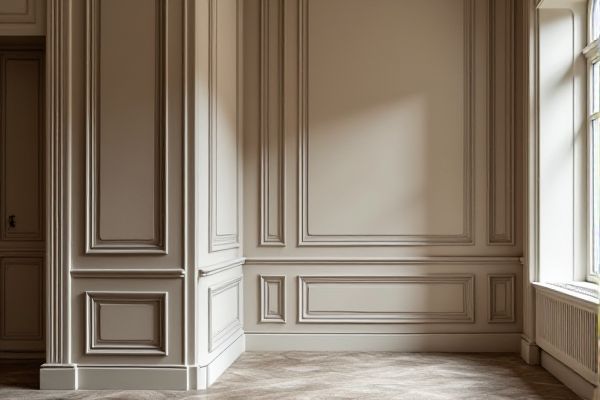
Nail trim provides a sleek, narrow edge that creates a subtle, polished finish, while piping detail adds a raised, decorative border that enhances texture and visual interest on upholstery or cushions. Explore the rest of the article to discover which option best suits your design preferences and project needs.
Table of Comparison
| Feature | Nail Trim | Piping Detail |
|---|---|---|
| Definition | Decorative edging created using small nails or tacks along furniture upholstery or leather. | Narrow, corded fabric sewn into seams for a raised, finished edge appearance. |
| Purpose | Secures upholstery; adds a classic, handcrafted look. | Enhances design; defines shape and structure with a clean line. |
| Materials | Metal nails or tacks, often brass or antique finish. | Fabric-wrapped cord, matching or contrasting upholstery fabric. |
| Installation | Manually hammered along edges; labor-intensive. | Sewn into seams during upholstery process. |
| Style | Traditional, vintage, rustic, or classic furniture styles. | Modern, tailored, or contemporary furniture aesthetics. |
| Durability | Highly durable; nails hold upholstery firmly in place. | Durable but depends on fabric wear and seam strength. |
| Cost | Generally higher due to manual labor and material costs. | Moderate; depends on fabric and sewing complexity. |
Introduction to Nail Trim and Piping Detail
Nail trim and piping detail are two distinct upholstery techniques that enhance furniture design and durability. Nail trim involves decorative metal nails applied along edges to secure fabric and add a rustic or classic aesthetic. Piping detail consists of fabric-covered cords sewn into seams, creating clean, tailored lines that emphasize the shape and structure of your furniture.
What is Nail Trim?
Nail trim refers to a decorative detail where small, evenly spaced metal nails or tacks are applied along the edges of furniture or upholstery to create a polished and classic look. This technique not only enhances the visual appeal but also reinforces the structure, ensuring durability. Your choice between nail trim and piping detail can influence the overall style, with nail trim offering a more traditional and sturdy finish.
What is Piping Detail?
Piping detail refers to a decorative technique that involves sewing a narrow strip of fabric, often with a cord inside, along the seams or edges of garments and upholstery to create a raised, defined line. This design element enhances the visual appeal by adding texture and contrast, making it a popular choice in fashion, home decor, and upholstery projects. Unlike nail trim, which uses small decorative nails for embellishment, piping detail emphasizes fabric manipulation for subtle sophistication.
Key Differences Between Nail Trim and Piping
Nail trim and piping are two distinct upholstery finishing techniques, with nail trim involving individual nails or tacks applied along edges for decorative and functional purposes, while piping consists of fabric-covered cords sewn into seams to create a rounded, raised edge. Nail trim offers a classic, handcrafted appearance and adds durability by securing fabric tightly to frames. Piping provides a softer, more tailored look and can be customized with contrasting colors or patterns to enhance furniture design.
Aesthetic Impact: Nail Trim vs. Piping
Nail trim offers a subtle, refined edge that enhances the structural lines of upholstery with understated sophistication. Piping detail adds a pronounced, decorative border that emphasizes contours and creates visual interest through texture and contrast. Your choice between nail trim and piping significantly influences the furniture's overall aesthetic, balancing between classic elegance and bold definition.
Durability and Maintenance Comparison
Nail trim offers superior durability with its metal studs firmly secured into the fabric, resisting wear and tear over time, while piping detail made of fabric or vinyl is more prone to fraying and discoloration with frequent use. Maintenance for nail trim typically involves occasional polishing or tightening to prevent loosening, whereas piping requires more careful cleaning to avoid damage or deformation. Your choice depends on whether you prioritize long-lasting strength or a softer, seamless aesthetic.
Applications: When to Use Nail Trim vs. Piping
Nail trim is ideal for applications requiring a clean, decorative edge on upholstery or cushions, enhancing durability and a tailored appearance. Piping detail is best suited for adding a raised, textured outline to fabric edges, providing a visually striking contrast and reinforcing seams in high-wear areas. You should choose nail trim when subtle accentuation is desired and piping for bold, structural design elements.
Cost Implications of Nail Trim and Piping
Nail trim detailing typically involves higher labor costs due to the meticulous handwork required, whereas piping detail offers a cost-effective alternative with machine-sewn precision allowing faster production. Material expenses for piping can be lower as it uses narrow fabric strips, while nail trim often demands additional embellishments increasing overall cost. Choosing between nail trim and piping impacts your budget significantly, with piping generally providing a more affordable solution for stylish finishes.
Pros and Cons of Nail Trim and Piping Detail
Nail trim provides a sleek, minimalistic finish that enhances fabric durability and is ideal for upholstery, but it can be difficult to achieve perfectly straight lines and may look dated in modern designs. Piping detail adds a decorative, dimensional edge that highlights seams and accents furniture or cushions, offering a classic or tailored look, yet it can increase production time and cost. Choosing between nail trim and piping depends on desired aesthetics, budget, and the specific application of the textile or furniture piece.
Choosing the Right Finish: Nail Trim or Piping Detail?
Choosing the right finish between nail trim and piping detail depends on the style and durability you desire for your upholstery. Nail trim offers a classic, handcrafted look with metal accents that provide sturdy protection along edges, while piping detail creates a smooth, tailored appearance enhancing fabric lines and contours. Your choice impacts both the visual appeal and longevity of the furniture, ensuring a finish that complements your design vision and functional needs.
 homyna.com
homyna.com